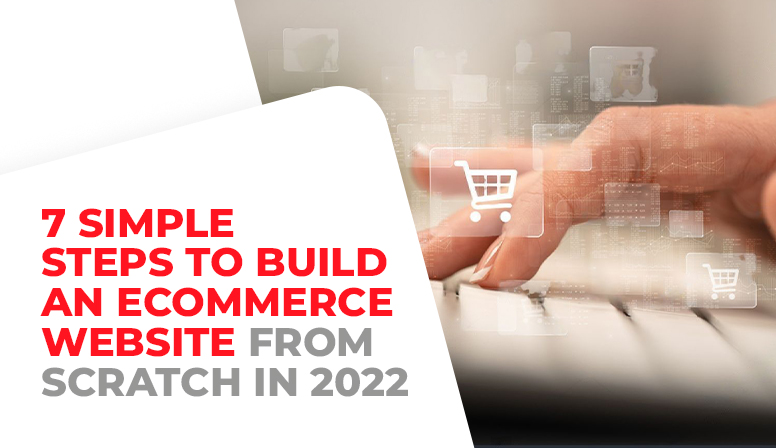If you have an online business that requires a customer-centric website or are searching for an eCommerce business, no other time is better than now to begin your venture. With more than 2 billion digital buyers worldwide, it is no surprise that the number of eCommerce will continue to grow. Online shopping allows buyers to purchase the items of their choice without facing traffic, parking, crowd, and weather issues. With the rapid growth in the commercial sector, it is clear why beginning an eCommerce site is profitable.
In the blog, we will focus on 7 simple steps to build an eCommerce website from scratch at the current time. We will focus on the best eCommerce tools available in the current market, looking to establish and track their website success. The beginning of an eCommerce business is an excellent move if you want to drive a good income. There are numerous eCommerce solutions and online store developers helping users create a website with a professional vibe. Digital Marketing Agency like Markethix will help you develop an advanced eCommerce website in 2022.
Steps to Develop an eCommerce Website from Scratch in 2022
1. Develop Your Ecommerce Marketing Strategy
First, you need to create a robust eCommerce marketing strategy. The strategy includes,
● Your business goals and objectives
● Key performance indicators (KPIs)
● Content marketing strategy
● Site content calendar.
● Social media promotion
An overall strategy development is the first and most vital step toward the development process. You must take time for ideation and invest in the relevant resources to complete the job. You must consider outsourcing if you don’t have the proper in-house infrastructure to carry out your strategy. Once you collaborate with your internal and external stakeholders to create an expansive e-commerce marketing plan, you are ready to begin with your eCommerce site.
2. Choose the Right Domain Name
A domain name is a core part of your website URL, which says about your business. The domain name typically involves the business name, and if the business name comes with other significant elements, you need to be creative to find an available domain. To find the most appropriate domain name for your business, you must run a little research. You may directly go to Google Domains or other domain name registrars or do a domain name search. You need to keep specific factors in mind while fixing your domain name:
● It should incorporate the name of your business
● It needs to offer the searchers some idea of what your business offers
● It must be more manageable for existing and potential customers to remember
3. Opt for Relevant eCommerce Tools
You need not worry if you fear thinking that you have to build an eCommerce site from scratch. The bright side is that entire site-building companies are trying to make the process easier. Once you opt for the site builder that works the best for your business, you can customize it and add more products under the supervision of Digital Marketing Agency experts.
The platforms offer comprehensive business solutions from domain name creation to site building.
4. Select an eCommerce theme or template
One of the significant factors to consider is a theme for your eCommerce website. You will find ready-made themes that will attribute your website a professional look and feel. The subscription platforms have tons of templates, so whether you create your eCommerce website with any platform, you will find several templates and themes, and you can choose one.
You need to keep in mind that while free templates are available across the platforms, some also offer paid templates. The advantages include offering many unique designs that give businesses a specific look and reduce customization time.
5. Customize Your Site and Create Product Listings
After you have found the perfect theme or template for your digital store, the next step is to customize it. You need to update the header and footer, configure your site’s navigation, and create pages from your homepage to the refund or return policy pages. A core component that establishes eCommerce websites apart from other types of websites is the product volume and relevant content. It will help if you have these to create to help your customers find what they are looking for. It might seem tempting to place all your products on one page, but it won’t lead to an excellent user experience.
Moreover, search engines won’t feature your site in the search engine result pages this way. Therefore, you must create product categories that make sense to the customers. You also need to create content or product description for every product you offer.
Online stores are incomplete without product listings. You need to organize and categorize your products so your future site visitors can easily find those, and you can manage them easily. Once you write your product description, blog content, page information, and other site content, you need to customize it to move on to the next step.
6. Determine Payment and Tax Options
Several ways exist to set up your eCommerce store’s point-of-sale and online payment processing systems. For shipping, you need to decide first whether your business will ship internationally or domestically. If you send abroad, ensure you understand how customs function for each country you are shipping to. You need to add inventory and tax tools to the eCommerce site and upgrade your site under the supervision of Digital Marketing Agency professionals. For domestic shipping, you can set up a USPS (United States Postal Service) account and manually work on the shipping prices. The benefit of using this method is that you don’t need to sign up for any additional carrier accounts to generate shipping.
7. Test and Launch Your Site
Before launching the eCommerce site to your customers, you must check the website thoroughly. Every single button and link on the site must be functional. You must design even the 404 error web pages based on the theme. You must run tests to see if you can add products to the carts and process the payment. Several platforms allow you to test payment processing without charging your credit card. Ensure you send all the emails to the right inboxes after a canceled purchase. Check how your site looks and functions on mobile devices. You can check the site’s performance on different web browsers.
After testing all the aspects, you are ready to launch your website. If you have the budget, you can go for paid advertising on Facebook, Google, and other social media platforms. You can announce the launch through your social media pages, blogs, guest posts, influencer marketing, and email marketing.
It is an exciting part to create an eCommerce site for your business. You can appoint site expertise and leverage the right tools to have a fully-functioning website in no time. The most important thing to remember while building your website is your customers. The eCommerce website projects your online brand presence. You must take care to build it in a way making it easier for customers to experience your brand. It is essential to help digital marketing agency professionals develop your eCommerce website from scratch. For more insights and suggestions, consult our Markethix professionals.





0 Comments